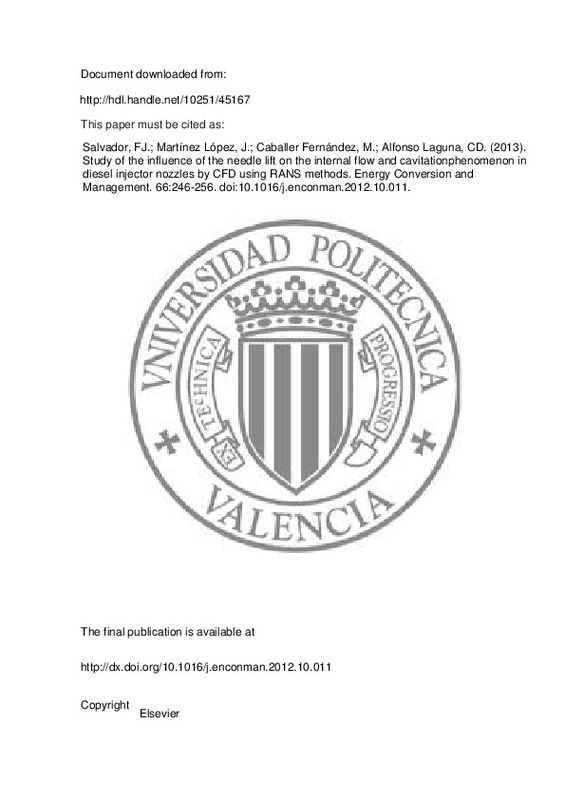JavaScript is disabled for your browser. Some features of this site may not work without it.
Buscar en RiuNet
Listar
Mi cuenta
Estadísticas
Ayuda RiuNet
Admin. UPV
Study of the influence of the needle lift on the internal flow and cavitationphenomenon in diesel injector nozzles by CFD using RANS methods
Mostrar el registro sencillo del ítem
Ficheros en el ítem
| dc.contributor.author | Salvador, F. J.
|
es_ES |
| dc.contributor.author | Martínez López, Jorge
|
es_ES |
| dc.contributor.author | Caballer Fernández, Miguel
|
es_ES |
| dc.contributor.author | Alfonso Laguna, Carlos de
|
es_ES |
| dc.date.accessioned | 2014-12-04T11:31:59Z | |
| dc.date.available | 2014-12-04T11:31:59Z | |
| dc.date.issued | 2013-02 | |
| dc.identifier.issn | 0196-8904 | |
| dc.identifier.uri | http://hdl.handle.net/10251/45167 | |
| dc.description.abstract | It is well known that cavitation phenomenon in diesel injector nozzles has a strong influence on the internal flow during the injection process and spray development. However, its influence on the flow during needle opening and closing remains still unclear due to the huge difficulties related to performing experiments at partial needle lifts. In this paper, an extended computational study has been performed in a multi-hole nozzle modeling 10 different fixed needle lifts. The internal flow has been modeled with a continuum nozzle flow model that considers the cavitating flow as a homogeneous mixture of liquid and vapour. Due to high Reynolds numbers, turbulence effects have been taken into account by RANS methods using a RNG k e model. Firstly, the code has been validated against experimental data at full needle lift conditions in terms of mass flow, momentum flux and effective velocity, showing a fairly good agreement with experimental results. Once the code has been validated, it has been possible to study in depth the internal nozzle flow and its characteristics at the outlet at different partial needle lifts. Nevertheless, not only the main flow features have been explained, but also the cavitation appearance and the turbulence development, which present huge differences between the different needle lifts simulated. | es_ES |
| dc.description.sponsorship | The authors wish to acknowledge the Generalitat Valenciana for the financial support through the project GVA PROMETEO CMT 2010 (reference code: GR001/2009/00167539). | en_EN |
| dc.language | Inglés | es_ES |
| dc.publisher | Elsevier | es_ES |
| dc.relation.ispartof | Energy Conversion and Management | es_ES |
| dc.rights | Reserva de todos los derechos | es_ES |
| dc.subject | Cavitation | es_ES |
| dc.subject | Diesel | es_ES |
| dc.subject | Ingection | es_ES |
| dc.subject | Needle lift | es_ES |
| dc.subject | Nozzle | es_ES |
| dc.subject.classification | MAQUINAS Y MOTORES TERMICOS | es_ES |
| dc.title | Study of the influence of the needle lift on the internal flow and cavitationphenomenon in diesel injector nozzles by CFD using RANS methods | es_ES |
| dc.type | Artículo | es_ES |
| dc.identifier.doi | 10.1016/j.enconman.2012.10.011 | |
| dc.relation.projectID | info:eu-repo/grantAgreement/GVA//GR001%2F2009%2F00167539/ | es_ES |
| dc.rights.accessRights | Abierto | es_ES |
| dc.contributor.affiliation | Universitat Politècnica de València. Departamento de Máquinas y Motores Térmicos - Departament de Màquines i Motors Tèrmics | es_ES |
| dc.contributor.affiliation | Universitat Politècnica de València. Instituto de Instrumentación para Imagen Molecular - Institut d'Instrumentació per a Imatge Molecular | es_ES |
| dc.description.bibliographicCitation | Salvador, FJ.; Martínez López, J.; Caballer Fernández, M.; Alfonso Laguna, CD. (2013). Study of the influence of the needle lift on the internal flow and cavitationphenomenon in diesel injector nozzles by CFD using RANS methods. Energy Conversion and Management. 66:246-256. https://doi.org/10.1016/j.enconman.2012.10.011 | es_ES |
| dc.description.accrualMethod | S | es_ES |
| dc.relation.publisherversion | http://dx.doi.org/10.1016/j.enconman.2012.10.011 | es_ES |
| dc.description.upvformatpinicio | 246 | es_ES |
| dc.description.upvformatpfin | 256 | es_ES |
| dc.type.version | info:eu-repo/semantics/publishedVersion | es_ES |
| dc.description.volume | 66 | es_ES |
| dc.relation.senia | 233095 | |
| dc.contributor.funder | Generalitat Valenciana | es_ES |







![[Cerrado]](/themes/UPV/images/candado.png)

